14 Types of Orange Mushrooms (with Pictures) – Identification Guide
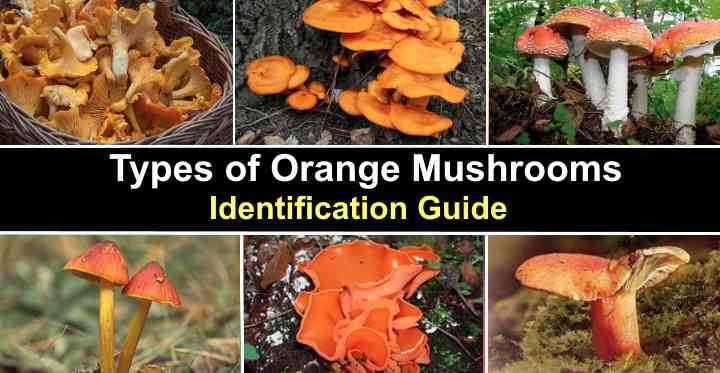
Orange mushrooms growing in your yard or lawn can seem to appear overnight. Bright orange mushrooms are easy to spot growing among blades of grass in dark, shaded areas, or on rotting tree trunks. Species of these orange fruiting bodies can grow in spongy clusters or have cylindrical stems with rounded or flat caps with gills on their underside.
Although some varieties of orange mushrooms, like the golden chanterelle, are edible, many are highly poisonous. For example, the toxic orange mushroom, Jack-O’lantern (Omphalotus olearius), is easily mistaken for a chanterelle because it has a similar shape and deep yellow to orange cap.
This article is only a general guide to identifying varieties of orange mushrooms common in yards and lawns. However, its purpose is not to advise on how to identify edible orange mushrooms from poisonous mushrooms. Mushroom foraging for consumption requires expert knowledge and experience. Therefore, never eat any type of mushroom without correctly identifying the species.
Descriptions and pictures of orange mushrooms and toadstools will highlight identifying features to look for. Please read on to learn about the types of wild orange mushrooms you could find growing in your yard.
Orange Mushrooms in the Lawn
Clusters of orange mushrooms are common sights in lawns in the fall after abundant rain. The bright to deep orange shades of these orange fruiting fungi contrast with dark green turfgrass. Common orange lawn mushrooms include the Jack-O’lantern (Omphalotus olearius), orange peel mushroom (Aleuria aurantia), and the bright orange goblet waxcap mushroom (Hygrocybe Cantharellus).
Why Mushrooms Grow in the Yard
Orange mushrooms grow in your yard because fungi in the soil start fruiting under ideal conditions. Like all fungi, wild orange mushrooms are small fruiting bodies that thrive in rich soil, shaded conditions, warm temperatures, and high humidity. Hence, you will most likely find lawn mushrooms in yards in late summer and fall.
You will likely find orange mushrooms near decaying organic matter growing in shaded conditions in your yard. Therefore, wild mushrooms are common under shrubs, in mulch, in the grass, and where tree trunks enter the ground.
What should you do if you find brightly colored orange or orange-red mushrooms in your yard? Generally, you can leave them alone. However, if you are unsure of the species and kids or pets play in the garden, removing them is best.
How to Identify Orange Mushrooms
Apart from their shades of orange, identifying features of orange mushrooms are the shape of the cap, stem, and size. After picking the mushroom, look to see if the cap’s underside has gills, pores, or a spongy feel. Then examine the mushroom’s color and the color of the flesh.
Some identifying features of edible species of mushrooms are their brown, orange, or tan gills, brownish orange caps, and smooth caps without scales or warty growths. Also, there should be no veil-like ring around the stem. However, these are only general guidelines, and you should never identify mushrooms based solely on these criteria.
Types of Orange Mushrooms (With Pictures) – Identification Guide
Let’s look in more detail at common mushrooms with orange fruiting bodies in shades of yellow-orange, red-orange, or pale orange with white spots. The chances are that some of these varieties of orange mushrooms are growing in your lawn or backyard.
Jack-O’Lantern Mushroom (Omphalotus olearius and Omphalotus illudens)

Jack-O’Lantern mushrooms: Top: Omphalotus olearius. Bottom: Omphalotus illudens (eastern Jack-O’lantern)
The jack-o’lantern mushroom is one of the most common orange mushrooms you will find growing in your yard. This common mushroom, with its deep orange shades, has a broadly convex round, indented cap, bright yellowish-orange to brownish-orange color, gills running the length of its tapering stem, and pale orange flesh.
The Jack O’Lantern is a relatively large, brightly colored orange mushroom. Its cap measures 1.5” to 4.7” (4 – 12 cm) wide, and its thick, orange stem is 1.3” to 3.5” (4.3 – 9 cm) tall. Apart from growing in your yard, this orange mushroom commonly grows at the base of tree stumps and roots.
This poisonous orange mushroom is a dangerous look alike to chanterelle mushrooms.
Orange mushroom identification
The jack-o’lantern mushroom is identified by its orange color, brownish-orange cap, and fluted gills tapering down the stem. In addition, this glow-in-the-dark mushroom is bioluminescent with a bluish-green color.
Chanterelle Mushrooms
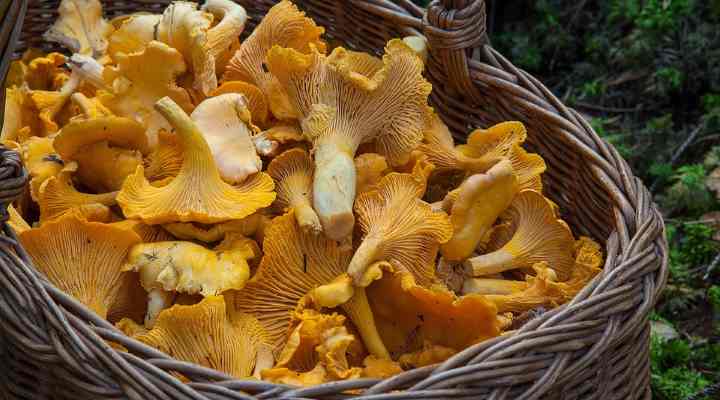
The edible orange-yellow chanterelle mushrooms are commonly found in shaded areas and coniferous forests
Chanterelle mushrooms are medium orange to yellow edible mushrooms with a broadly flat, convex orange cap. Identifying features of orange chanterelles are the slightly depressed cap’s center, false gills under the cap, and pale yellowish flesh. Some species of chanterelle are red-orange to deep red, like the red chanterelle.
Pale yellowish-orange chanterelles have a distinct vase shape. The tasty mushrooms grow 1.5” to 2.3” (4 – 6 cm) tall, and their cap is 1.1” to 4” (3 – 10 cm) wide. Chanterelles are common throughout North America. You will typically find orange chanterelle mushrooms in coniferous forest floors and shaded areas.
Orange mushroom identification
Chanterelle mushrooms are easy to spot due to their yellow-orange color, tapering long stem, and tiny black scales on the cap.
Orange Fly Agaric (Amanita muscaria var. guessowii)
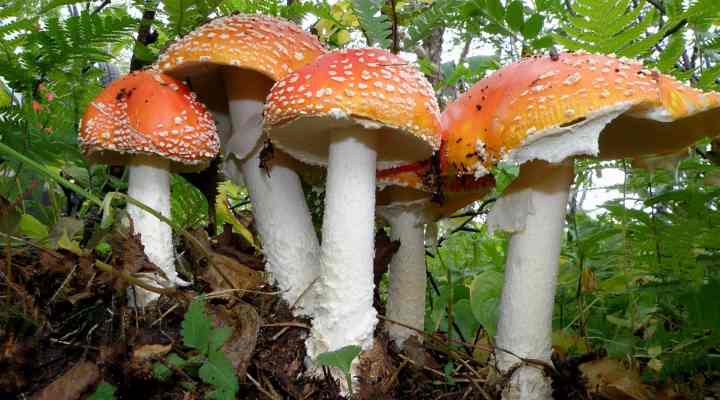
The poisonous fly Agaric mushroom is identified by an orange-reddish cup with white specs
The orange fly agaric is a highly poisonous mushroom with a cylindrical white stem, orange cap, and white warty growths. The large orange cap can be umbrella-shaped or like a flattened disc. This orange-red mushroom also has a variation of a bright red and white toadstool, the red fly agaric.
The orange fly agaric has a large cap 2.7” to 8.2” (7 – 21 cm) across, and the large orange mushroom grows 2.7” to 7” (7 – 18 cm) tall. Sometimes growing in lawns in shaded, sheltered locations, the orange mushroom is typically found near birch trees or in coniferous woodlands.
Orange mushroom identification
The orange fly agaric has a rounded orange cap covered in small bumpy white growths. It’s got white flesh, white gills, and a distinctive orange-red cap.
Orange Peel Fungus (Aleuria aurantia)
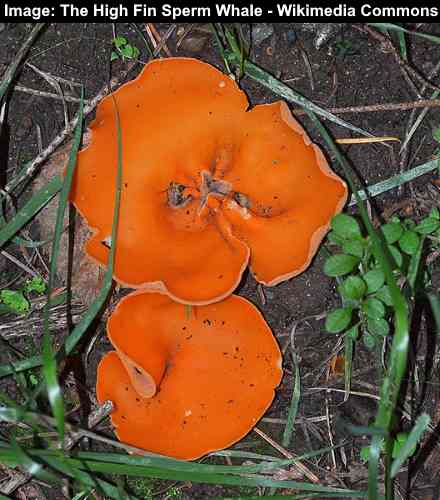
The orange peel fungus is a stemless lawn mushroom with a crinkled look
The cup-shaped orange peel fungus is a brilliant orange mushroom with a distinctive crinkled appearance. This common orange lawn fungus is distinguished by its wavy, smooth, bright orange cap that looks like a large slice of orange peel curled on its side. In addition, the irregularly shaped fungus has a fuzzy underside.
The fruiting body of this unusual stemless orange fungus grows 0.6” to 2.7” (1.5 – 7 cm) across. You can often find this vibrant orange mushroom in grassy areas, trails, and residential yards.
Orange mushroom identification
The distinctive orange peel fungus has a unique cupped shape, sometimes with a split down one side. As the mushroom matures, it becomes more flattened.
The Orange Bonnet Mushroom (Mycena acicula)
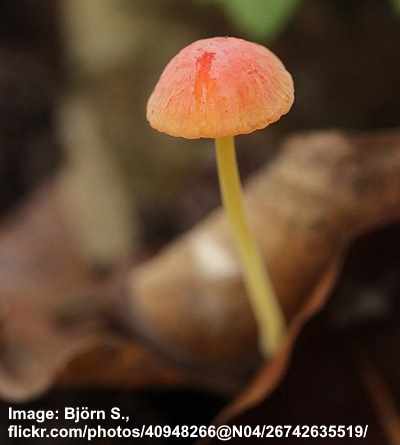
The orange bonnet mushroom is identified by a slender stem and orange small cap
The orange bonnet is an orange mushroom that grows in dense clusters. It is recognized by its slender, curving stem and bell-shaped cap. The rounded, bright orange cap develops a conical shape as it grows. Under the bell-like cap are closely spaced orange gills with red-orange margins. The sticky orange mushroom also has dense hairs at its base.
The cluster-forming orange mushrooms grow 1.1” to 2.7” (3 – 7 cm) long with wiry stems a few millimeters thick. The small, slimy orange caps measure between 0.39” to 1.5” (1 – 4 cm) wide with a somewhat rounded, conical appearance. The clusters of orange mushrooms are found on the floor of deciduous forests.
Orange mushroom identification
The tiny orange mushrooms have dull orange caps on top of slender yellowish-green stems with bright orange gills underneath the cap.
Goblet Waxcap (Hygrocybe cantharellus)
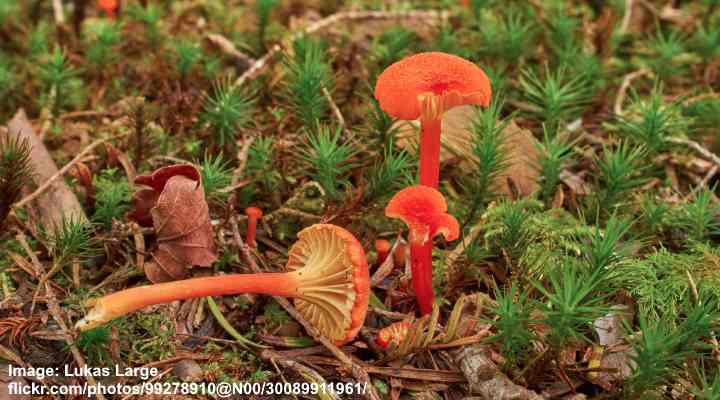
The small goblet waxcap is a bright orange mushroom with a thin stem and can be found near hardwood trees and lawns
The goblet waxcap is a small bright orange mushroom with a long, slender orange stem, a round orange cap with in-rolled margins, and attractive white to yellowish-white gills underneath. Other identifying features of the orange mushroom are its sticky feel, bright orange cap with a scalloped margin, and yellow-orange flesh.
The tiny goblet waxcap mushroom grows 1.1” to 2.75” long, and (3 – 7 cm) its small disc-like orange cap is 0.2” to 0.78” (0.6 – 2 cm) across. The orangish mushrooms grow in loose clusters near hardwood trees in deciduous woodlands and sometimes in lawns.
Orange mushroom identification
Identifying features of the goblet waxcap are its long, slender stem, white gills, and broadly convex and scalloped cap that is sticky to the touch.
Red Pine Mushroom (Lactarius deliciosus)
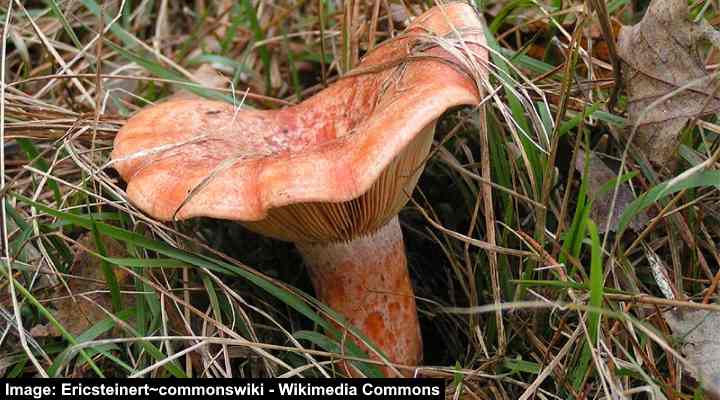
The red pine mushroom has orange mottled patterns and stout look and can be found near pine trees
The red pine mushroom is a robust, vase-shaped fungus with a carrot-orange cap that has a sticky feel when wet. The orange mushroom is relatively stout, with noticeable pale orange gills tapering down the stem. When fresh, the fungus secretes an orange-red sticky liquid. After handling, the mushroom develops greenish stains.
Also called the saffron milk cap due to the latex-like orange liquid it emits, the red pine squat mushroom grows 1” to 3” (3 – 8 cm) tall and 1.5” to 5.5” (4 to 14 cm) across. As its name suggests, the orange mushroom is commonly found in coniferous forests near pine trees.
Orange mushroom identification
The short, stumpy orange pine mushroom is identified by its vase-shaped appearance, mottled patterns, and evenly-spaced yellow gills.
Bradleys Mushroom (Lactarius volemus)
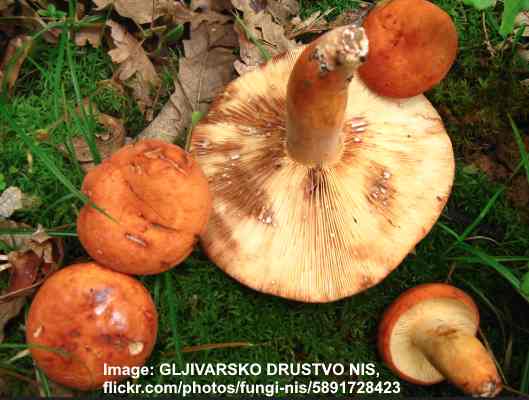
The orange-brown Bradleys mushrooms have foul odor and are found growing in deciduous or coniferous forests
Bradleys mushroom is a type of edible orange mushroom with an inward turning, burnt orange round cap, bright yellow gills, and a thick, tubular stem. The orange mushroom typically grows solitary. Other features of the orangish-brown mushroom are the milky-white sap, tapering gills, and white flesh that stains brown.
Bradleys mushroom grows 2” to 4” (5 – 10 cm) tall, and its large disc-shaped cap with tapering gills are 1.1” to 5.1” (3 – 13 cm) in diameter.
Orange mushroom identification
The Bradleys mushroom is identified by its apricot to tawny colored cap that can sometimes be dark brownish-red. However, this orange mushroom is mostly noted for its stinky fish odor and the copious milky white sap it exudes when cut.
Woolly Chanterelle (Turbinellus floccosus)
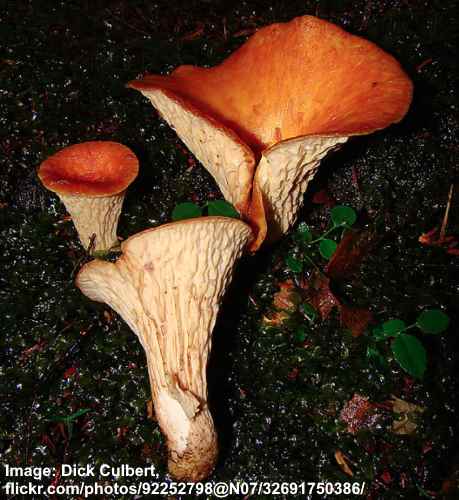
The woolly chanterelle mushroom has an orange-brown cap and white stem and gills
The unmistakable woolly chanterelle is a vase-shaped, fleshy orange mushroom with a dark orange to brown upper surface and bright white gills on the underside. The fruiting body develops into a trumpet shape as it grows near conifer trees. The mushroom’s flesh is fibrous and easily discolors with brown patches.
The distinctive woolly chanterelle is a tall orange mushroom that can grow 12” (30 cm) tall and wide. The wide top and tapered gills with their pale buff to whitish or yellowish ridged appearance make it easy to spot.
Orange mushroom identification
The woolly chanterelle is easily recognizable by its cylindrical vase-shaped appearance, thick, fibrous flesh, and shades of deep red to yellowish-orange.
Jackson’s Slender Amanita (Amanita jacksonii)
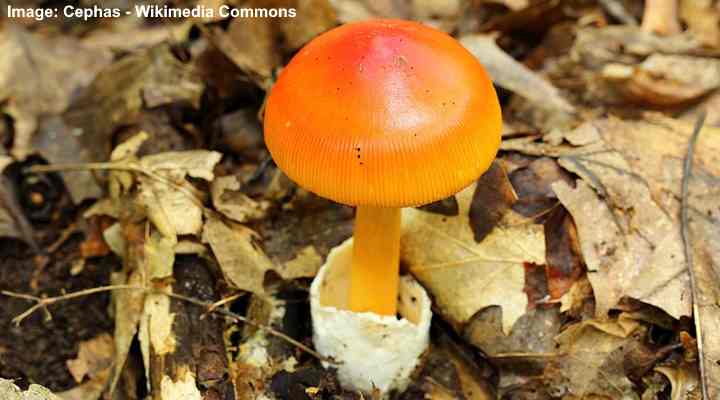
The Jackson’s slender amanita mushroom has an orange-reddish cup and yellowish stem and is often found near oaks and pine trees in late summer and fall
The Jackson’s slender amanita is a relatively large orange mushroom with a tall, cigar-shaped stem and deep orange convex or umbrella-shaped cap. The distinctive features of this wild orange mushroom are its yellow stems, yellowish gills, and bright orangey-red appearance. In addition, the mushroom has a smooth, sticky feel to the cap.
The Jackson’s slender amanita grows 3.5” to 6” (9 – 15 cm) tall, and its cap is 2” to 4.7” (5 – 12 cm) across. This edible orange mushroom is easily confused with poisonous mushrooms like the fly amanita.
Orange mushroom identification
The identifying features of the Jackson’s slender amanita are its tacky, orangey-red convex cap, yellowish gills, and slender yellow cylindrical erect stem.
Chicken of the Woods Mushrooms (Laetiporus sulphureus)
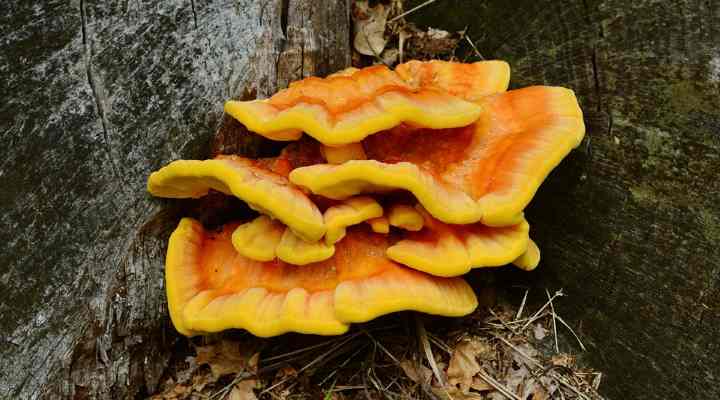
The orange-yellow chicken of the woods mushrooms grow in clusters on dead oak tree trunks
Chicken of the woods is a type of cluster-forming orange fungus that creates shelf-like, overlapping growths on trees. This parasitic golden yellow or orange fungus looks like fan-shaped shelves on a rotting tree trunk. Fresh fungi emit a strong, earthy aroma and exude a pale transparent yellow liquid.
The shelf-like structures of this common woodland fungus measure between 2” and 24” (5 – 60 cm) and up to 1.5” (4 cm) thick. Because of the clumping nature, the large yellowish-orange fungus can become huge orange growths. Additionally, the parasitic fungus kills the host tree long before the edible, yellow-pored fungus appears.
Orange mushroom identification
The easy-to-identify chicken of the woods has large golden orange shelf-like structures attached to dead oak tree trunks. Other common names for the orange fungus are sulphur shelf, crab of the woods, and sulphur polypore.
The Golden Trumpet (Xeromphalina Campanella)

The golden trumpet mushrooms grow in clusters and are identified by thin orange stems and small caps
The golden trumpet mushroom is a small rusty brown to dark orange mushroom growing in dense clusters. This orange mushroom is identified by its umbrella-shaped cap, thin dark orange stem, and pale orange gills. As the tiny mushroom matures, the bell-shaped caps grow upward, creating a distinctive vase shape.
The tiny orange mushrooms measure 0.6” to 1.1” tall (1.5 – 3 cm), and their yellowish-orange caps are 0.2” to 1” (0.5 – 2 cm) across. You can typically find clusters of these orange mushrooms growing on fallen logs and old tree stumps of old conifers.
Also called the bell omphalina or golden trumpet, these moisture-loving fungi grow throughout the year.
Orange mushroom identification
The golden trumpet mushroom is a small bunching orange mushroom species, identified by its umbrella-like cap that eventually grows into a funnel shape.
Conical Waxy Cap (Hygrocybe conica)
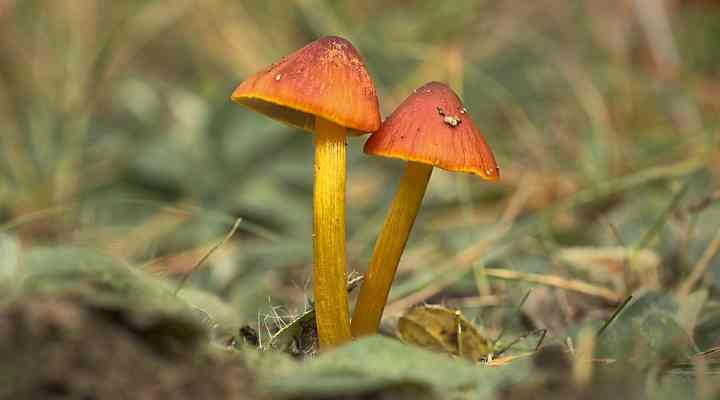
The conical waxy cap is a small orange mushroom with a yellowish thin stem growing under oak trees
The conical waxy cap is a small orange-topped or red-capped mushroom with a pointed sticky cap, erect yellow-orange stem, and white or orange-red gills. The orange-red mushroom caps emerge sharply conical and gradually flatten to a broadly convex shape with a pointed tip in the middle.
Also called the witch’s hat due to the cap’s shape, this orange conical waxy cap measures 1.18” to 3.14” (3 – 8 cm) tall, and the cap is 0.39” to 1.5” (1 – 4 cm) across. You will often find these pretty orangish mushrooms growing under oaks in woodlands.
Orange mushroom identification
The conical waxy cap mushroom has a distinctive broad cap with wavy margins and a pointed center.
Lobster Mushroom (Hypomyces lactifluorum)
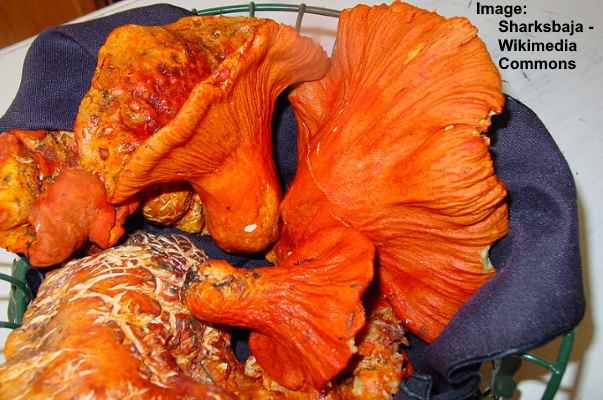
The lobster mushroom is a parasitic fungus that attached itself to a host mushroom, turning it orange color
The lobster mushroom is a parasitic type of fungus, not an actual mushroom. The fungus attaches itself to certain mushroom species, turning them a reddish-orange color. This gives the affected fungi a distinct cooked lobster coloration. As the parasitic fungus grows, it distorts the shape of the host mushroom, creating a tough, bright orange outer skin.
The size of lobster mushrooms depends on the size of the host mushroom. Lobster mushrooms are edible fungi and are sold commercially in some grocery stores. Their seafood-like flavor and dense texture make them a delicacy.
Orange mushroom identification
The identification features of a lobster mushroom are its bright reddish-orange coloring and hard surface dotted with tiny white pimples.
Learn how to identity common types of yard mushrooms.
Related articles:
